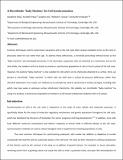A microfluidic “baby machine” for cell synchronization
Author(s)
Shaw, Josephine; Payer, Kristofor Robert; Son, Sungmin; Grover, William H.; Manalis, Scott R
Downloadentire article (1.572Mb)
OPEN_ACCESS_POLICY
Open Access Policy
Creative Commons Attribution-Noncommercial-Share Alike
Terms of use
Metadata
Show full item recordAbstract
Common techniques used to synchronize eukaryotic cells in the cell cycle often impose metabolic stress on the cells or physically select for size rather than age. To address these deficiencies, a minimally perturbing method known as the “baby machine” was developed previously. In the technique, suspension cells are attached to a membrane, and as the cells divide, the newborn cells are eluted to produce a synchronous population of cells in the G1 phase of the cell cycle. However, the existing “baby machine” is only suitable for cells which can be chemically attached to a surface. Here, we present a microfluidic “baby machine” in which cells are held onto a surface by pressure differences rather than chemical attachment. As a result, our method can in principle be used to synchronize a variety of cell types, including cells which may have weak or unknown surface attachment chemistries. We validate our microfluidic “baby machine” by using it to produce a synchronous population of newborn L1210 mouse lymphocytic leukemia cells in G1 phase.
Date issued
2012-04Department
Massachusetts Institute of Technology. Department of Biological Engineering; Massachusetts Institute of Technology. Department of Mechanical Engineering; Massachusetts Institute of Technology. Microsystems Technology Laboratories; Koch Institute for Integrative Cancer Research at MITJournal
Lab on a Chip
Publisher
Royal Society of Chemistry, The
Citation
Shaw, Josephine, Kristofor Payer, Sungmin Son, William H. Grover, and Scott R. Manalis. “A Microfluidic ‘baby Machine’ for Cell Synchronization.” Lab Chip 12, no. 15 (2012): 2656.
Version: Author's final manuscript
ISSN
1473-0197
1473-0189